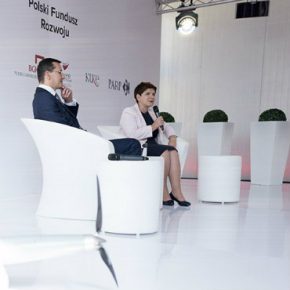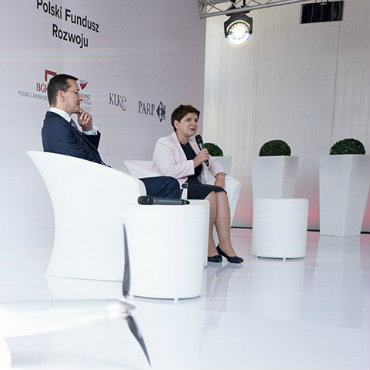Tydzień w gospodarce
Category: Raporty

Polish PM Beata Szydło and Deputy PM Mateusz Morawiecki, Krynica, Poland (Kancelaria Premiera, CC)
So far, the Plan for Responsible Development, known colloquially as the Morawiecki Plan, predicted that the pool of development expenses could reach PLN1 trillion. However, it has turned out that it could be twice the size if new areas of expenditure are taken into account.
“Recently we commissioned a summary of all the development expenditure up to 2023 and I think it comes to about PLN2 trillion,” Jerzy Kwieciński, Deputy Minister of Development, told the CE Financial Observer.
“Now we know that expenditure up to 2020 will come to PLN1.5 trillion, so by the end of the current EU perspective till 2023 there should be proportionately more. The new estimates are due to the fact that we have been poring over the finances and we have included such expenditure which in the world is considered to be pro-development in health, education and local government budgets,” explained the deputy minister.
The Morawiecki Plan, presented by the government in February, also brought a list of eight flagship projects with impressive names. The “Żwirko and Wigura” Program will create Polish drones, the “Bathory” Program should build a Polish passenger ferry, “Luxtorpeda 2.0” to build high-speed trains, and the “Polish Mining Combine” to expand the potential exports of mining and construction machinery. On top of these there are the “Kazimierz Funk Centre for Development of Biotechnology”, the “Polish Medical Products” Program, “Cyberpark Enigma” and the “Medium-Sized Cities as Centres of Advanced Outsourcing”.
Out of these the “Bathory” Program has started. In June, a letter of intent was signed and indicates that the Polish shipyards will build two car-passenger ferries for Polish Baltic Shipping Company (Polska Żegluga Bałtycka). The first ferry is to be completed in 2019.
“This list is not written in stone. We are approaching this flexibly and we do not rule out that certain initiatives will not be implemented but also that completely new ones may appear. Everything depends on the private sector. The private sector, and not the government, will carry out the ventures which suit it. Our role is, for example, to announce research and development programs for specific sectors, e.g. the railways, for electric vehicles, and the companies will deal with the rest,” explained Jerzy Kwieciński.
An idea which was not included in the February presentation of Deputy Prime Minister Morawiecki, but which now makes the headlines, is electro-mobility, in other words the plan to build Polish electric buses.
“We want to have an excellent export product with a competitive price and outstanding quality that will first of all be tested on the beta market, on the Polish market in cooperation with local government, and which will then become our flagship export product,” Jadwiga Emilewicz, Deputy Minister of Development, said in Krynica. The presence in the same panel of managers from Solaris and Ursus confirmed that the government’s initiative will be implemented.
In fact, electric buses have many advantages: they are ecological, quiet, and although they are more expensive, they are cheaper to maintain than the traditional vehicles. Lucjusz Nadbereżny, Mayor of Stalowa Wola, quoted specific numbers. During tests in his town it turned out that the average operating cost of a bus with a diesel engine is PLN110 per 100 km. An electric bus will travel the same distance for PLN42 with air-conditioning switched on.
Everyone stressed that Poland only has one or two years to create the standards that will be adopted by this new industry.
“This program can generate a whole value chain: from engines and batteries which perhaps we will produce in Poland, to buses and infrastructure. However, without the participation of the energy sector we will not manage to carry it out,” argued Professor Grzegorz Benysek, director of the Institute of Electrical Engineering.
In his opinion, it is necessary for the energy companies to collect and reuse used batteries from the buses, which would allow the reduction of the vehicles’ costs. The development of such a business model is very important, because we might not succeed in producing cells to the batteries, just like nobody has yet succeeded in Europe. Then, the advantage of the Polish electric bus would depend on the skilful integration of cells from the Far East with the greatest number of other Polish components possible and the development of a charging system during operation.
The Minister of Development, Mateusz Morawiecki, promoted the program House+, the program for construction of flats for rent (with the option of eventual ownership) on land belonging to local government and companies of the State Treasury. In the heat of discussion he even gave an example of the amounts.
“In a situation in which we build for PLN2,500-3,000 per square meter (sqm) and sell in Siedlce for PLN3,000-3,500, in Łódź for the same amount instead of PLN4,000, in Kraków for PLN4,500-5,000 instead of PLN5,000-6,000, and in Warsaw for PLN4,500-5,000 instead of PLN6,800 or even PLN25,000, then this capital will be saved for much more productive sectors,” he explained.
These calculations were commented by Grzegorz Kiełpsz, President of the Polish Association of Developer Companies, who spoke with the CE Financial Observer.
“I think that we can count on a 10 per cent fall in prices. If an apartment in Warsaw’s Tarchomin costs PLN6,500 per sqm with VAT, and we deduct from that the developer’s margin, which on average amounts to 10 per cent, then we are left with PLN5,850. If we deduct from this 1-2 per cent of marketing and sales costs, then we are left with a final amount of a minimum of PLN5,700,” he said.
“Of course, it is possible to do it cheaper. Even now one of the developers is building commercial apartments for PLN3,600 per sqm with VAT. A price of PLN4,500-5,000 could be achieved in the suburbs of Warsaw, although there you have to take into account large expenditure on infrastructure,” he added.
By the end of the day, everything will depend on the land that is made available by local governments and state-owned companies.
Mirosław Barszcz, CEO of BGY Nieruchomości, told the CE Financial Observer that the initial estimates suggest that as much as several thousand plots of land may be suitable for the program.
“However, the State Treasury does not have too many plots that would be perfect for low-cost renting. Rather, we have expensive plots of land in the city centres. It would be necessary to sell them in order to buy other plots, which is why there is pressure to involve local governments in the program, whose portfolio of land seems to be much more interesting,” said Mirosław Barszcz.
The CEO of BGK Nieruchomości stressed that local governments interested in participating in the program will be treated as commercial partners. Their land will be valued commercially and they will receive investment certificates which will bring a certain income. The fund has at its disposal PLN5bn but in the case of great interest, thanks to leverage, that amount can be increased to as much as PLN20bn.
The only lack of optimism at Krynica was among those responsible for the railways, especially cargo transportation. Cargo trains travel on Polish rails at a speed of 25 km per hour, which is why only large cargo transports are profitable above 750 km. Everything else is loaded onto lorries which wear out the roads at a fast pace.
Although the railways are favoured in the current EU perspective at the expense of road transportation, it is still necessary to use this money somehow and break the habit of closing rail lines during repairs that last an eternity.
“For a long time we have been saying that we do not have to run the trains during the day. We can run our trains at night, on Sundays and bank holidays, but in such a way that the route is open, because contractors in Poland don’t repair something 24 hours a day. Let’s do it so that the rail routes are open,” appealed Maciej Libiszewski, CEO of PKP Cargo.



